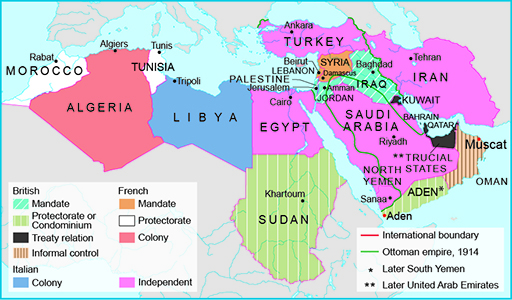2.1 The interwar period and great power politics
The political map of the modern Middle East is a product of the contrasting fortunes of the key belligerent powers that took part in the First World War, including victorious Britain and France and the vanquished Ottoman Empire. While the war was still raging across Europe and the Middle East, in 1916 British and French officials met in secret to sign the Sykes–Picot agreement, agreeing on a division of the Ottoman Empire following the end of the First World War. The British also supported a revolt in 1916 against the Ottomans in the Arabian Peninsula by the Sharif of Mecca, eventually leading to the establishment of what would become modern-day Saudi Arabia, still ruled by the House of Saud.
Following the end of the First World War, the defeated Ottoman Empire, which sided with Germany and the Austro-Hungarian Empire, was largely dismembered, leaving a rump state based around modern-day Turkey. A substantial portion of the territory previously controlled by the Ottoman Empire in the region was placed under de facto British and French rule, as ‘mandated territories’ under the auspices of the League of Nations (the forerunner to the United Nations (UN)). Following on from the stipulations of the Sykes–Picot agreement, the territories of modern-day Syria and Lebanon fell under French control, while present-day Palestine/Israel, Jordan and Iraq were administered by the British.
Figure 4 shows various territorial divisions, and with it, varying forms of imperial control. The British and French mandates over former Ottoman provinces, agreed by the victors following the San Remo Conference of 1920, gave the two then-imperial powers a role in providing the necessary administrative advice and assistance to prepare them for eventual independence. These joined the pre-existing ‘protectorates’ already administered by Britain and France in and around the region, whereby territories were subject to imperial control through military ‘protection’ for favoured local rulers, and more formal colonies, such as Algeria, which was subject to direct rule from Paris.
The establishment of the State of Israel in 1948 entailed further territorial division that continues to be a source of conflict today. The Holocaust led to increased support for a Jewish homeland in Palestine, which had been gaining momentum since the Balfour Declaration of 1917. This had seen the British government announcing its support for the World Zionist Organization’s goal of establishing a Jewish homeland in Palestine, subsequently paving the way for large-scale Jewish immigration there during the interwar period. Following a bitter conflict between the established Arab and more recently arrived Jewish populations in the then-Palestinian mandate territory, the British hastily withdrew, paving the way for the declaration of the State of Israel. The first, interstate Arab–Israeli war quickly followed as a coalition of Arab states sought to take control of Palestinian-inhabited areas.
Although only lasting a few decades, the colonial period in the region built on centuries of informal influence, and it went on to have a major impact on its politics and society, helping to establish the administrative, juridical and military structures that subsequently shaped its international relations (Halliday, 2006, p. 83). For example, sectarian divisions in Lebanon were utilised by France to favour a Christian elite at the expense of its Muslim majority population – itself also divided along Sunni and Shia lines – and that helped sow the seeds for a decades-long civil war in the 1970s and 1980s. Sectarian divisions in Lebanon are still notable in the present day, continuing to form the basis of external powers’ engagement with different groups there. Claims for self-determination around the interwar period were in some cases refused, as seen with the rejection of Kurdish aspirations for an independent homeland, or granted if they served great power interests, as seen with allied powers’ support for the Arab revolts noted earlier.
Revisiting Activity 1
At the start of this course you were asked to note down a state that was of interest to you, and to think about some of the ways its present borders might have been influenced by its historical experiences. You can see your answers below. When looking back on these, is there anything that you’ve learned from the course that might help you look at this example differently? Perhaps there are aspects of its history or political formation that are worth investigating further which can help you understand that state’s present form and the nature of its international relations today.

